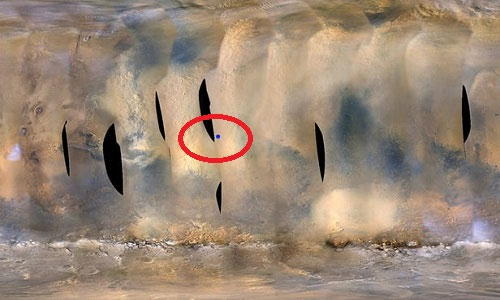NASA robots fight against dust storms as large as North America on Mars
NASA's "swallowing", almost completely paralyzed.
NASA's Opportunity Mars probe turns to a minimized mode of operation when covered by a cloud of dust that obscures the Sun, New Atlas yesterday reported. The storm was much stronger than originally anticipated, preventing the solar panel from fully charging the battery at the probe, but the mission said the NASA engineers obtained a signal from Opportunity on the morning of October 10. 6.
One of the unusual features of Mars is that the planet tends to form incredible dust storms. When the spacecraft flew around NASA's Mariner 9 orbit to Mars in 1971, the raging dust storm was so big that it covered the entire planet and covered the sunlight for two months.

The green dot in the circle is the position of Opportunity robot in dust storm.(Photo: NASA).
Unlike the Curiosity robot that operates on nuclear power, Opportunity relies on solar panels to fully charge batteries. If the solar panel does not receive enough sunlight, the battery pack will run out and the probe robot cannot run the heating device. Since the night on Mars can be cold to -143 ° C, Opportunity systems will freeze and never be restarted. The same thing is likely to happen to the Spirit robot in 2010.
According to NASA, the current storm was discovered by the ship spinning around the June 1 Mars Reconnaissance (MRO) . Dust storms cover an area of 18 million km², equivalent to the area of North America, including the position of Opportunity parked in the Perseverance Valley. The mission board fears the storm of dust in the air can increase the opacity to the point that the solar panels do not receive enough light. Therefore, exploration robots are ordered to suspend all scientific activities and focus battery power on operating heaters and telescopes.
However, the storm became more intense than expected. The same storm that Opportunity encountered in 2007 had a opacity of 5.5 tau, while the current storm is 10.8 tau. However, the mission control board could use Deep Space Network (DSN) to establish communications on June 10, proving that the exploration robot is still operating.
One benefit of dust storms is the role of insulation, keeping the temperature in the atmosphere, thereby limiting the fluctuations of extreme temperatures on the surface of Mars. The onboard device indicates the temperature of the probe robot is -29 ° C according to the most recent data transfer, depleting the battery while the system produces heat itself to keep the robot warm.
Opportunity was launched into space on July 7, 2003 on Delta II missiles from Cape Canaveral Air Force Station in Florida, USA. The Boeing 185 kg heavy-duty device was also named Mars Exploration Rover-B (MER-B) , landing at the Meridiani Planum area of Mars on January 25, 2004, three weeks after Spirit (MER-A). . Although only designed for 90-day operations, Opportunity continues to explore the red planet for more than 15 years.
- Dust from Asia stains North America
- Super dust storm 'devour' neighbor Earth?
- NASA develops dust storm forecasting technology on Mars
- Video: Large dust storms attack the United States
- The appearance of Mars suddenly changed completely after the dust storm
- Detecting 'ghost dust' on red planet
- Can the Mars probe ship be hit with dust?
- It turns out this is the cause of losing steam on Mars
- The two robots that explored Mars were active again
- America will put more robots on Mars
- Mars explorers encountered storms
- Giant dust demon on Mars
 Announced 3 houses on the Moon and Mars
Announced 3 houses on the Moon and Mars Science proves: Mars also knows 'deflated'
Science proves: Mars also knows 'deflated' Elon Musk announced the price for a Mars trip was 11.6 billion VND, free of charge
Elon Musk announced the price for a Mars trip was 11.6 billion VND, free of charge NASA discovered strange 'gate' on Mars, is the hiding place found?
NASA discovered strange 'gate' on Mars, is the hiding place found?